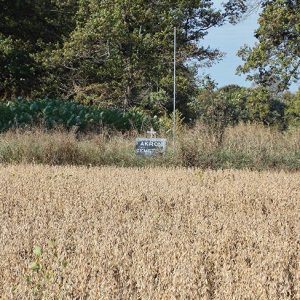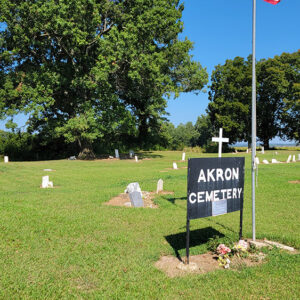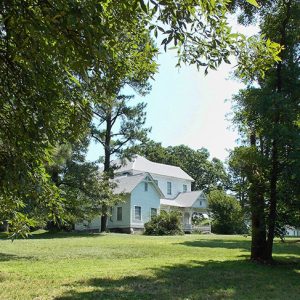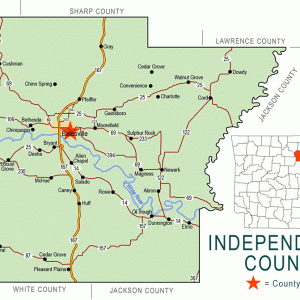calsfoundation@cals.org
Akron (Independence County)
Drivers heading south from Newark (Independence County) on Highway 122 will see an isolated cemetery marker at the dividing line between a wooded area and a farm field. The sign reads “Akron Cemetery” and marks the only remains of a once vibrant community. The community was at one time called Big Bottom for the rich and extensive bottom land on the north side of White River and the west side of Black River. The stage route from Batesville (Independence County) to Jacksonport (Jackson County) ran through Big Bottom/Akron.
The Akron Cemetery was listed on the National Register of Historic Places on October 4, 2002. The oldest recorded grave in the cemetery is from 1829, making this perhaps the oldest cemetery in the county. It was abandoned about 1940, but volunteers regularly undertake cleaning efforts. Eighty-six of the readable stones have been transcribed, one being the grave of Whorton R. Magness, the first postmaster of Big Bottom. The post office opened on November 22, 1854.
The Akron Cemetery lies atop a Native American mound. In 1882, Edward Palmer observed that the circular burial mound was seven feet high and 300 feet across. Palmer said that when graves were dug on top of the mound, artifacts were unearthed, and many were taken—including a fine carved shell and a number of shell beads that were later donated to the museum in Jacksonport. A figure of clay was also unearthed and sold to a dealer in St. Louis, Missouri. Palmer described a similar mound nearby, which was four feet high and fifty feet across. Several artifacts were excavated from the second mound.
The history of Akron begins with the Padgett family on a part of the Big Bottom area called Padgett Island, named for William Benjamin Padgett from Fairfax, Virginia, who farmed the area before the Civil War and later served in the Arkansas General Assembly. He was married to Phoebe Engles Padgett, a member of a prominent Independence County pioneer family that owned Engleside on the northern banks of White River near Batesville.
To the north and east of Padgett Island lies the backwater Big Bottom Slough (a.k.a. Island Sough), forming the “island” surrounded by the White River and the slough. By 1876, the area was called Big Bottom (and then later Akron). The Independence County Court appropriated $1,000 in 1907 for a steel bridge across the slough, with the farmers being required to pay the remaining cost. It was completed in 1909. The Padgett Island Bridge (a.k.a. Big Bottom Slough Bridge) still stands (though closed to all traffic) and was listed on the National Register of Historic Places on September 24, 2004.
The first known church in the Big Bottom/Akron area was located about two miles to the north and called Blue Springs Church. It has been labeled a Church of Christ, Church of God, and Christian Church. John M. Lemmons from Tennessee helped establish the church in 1851 and then continued his mission work with a congregation in Randolph County. Town lore holds that Lemmons was once in the process of baptizing a woman in the creek when her displeased husband shot at him. He later convinced the husband of the error of his ways and baptized him in the same creek. The congregation met in what was called a “union building,” as several different denominations met there. The Civil War split the church to such an extent that it was abandoned. In the years following the Civil War, the congregation established separate churches in Newark, Magness (Independence County), and Akron; by 1874, there were ninety-eight members of the Akron church, which was located by the cemetery. Eventually, the Akron congregation and a church called Centerpoint in Newark merged to form Cleghorn Chapel in Magness.
The name of the post office was changed from Big Bottom to Akron in 1880, with the population given as 100. The Akron post office was open from 1880 until 1900. These years represent the apex of the community’s existence. The first postmaster for Akron, William F. Moore, was appointed on March 17, 1880. His sister Elizabeth J. Moore was the wife of prominent farmer Jesse Alison Moore, the founder of Moorefield (Independence County). At its height, the village of Akron had a general store or trading post and post office, a blacksmith shop, the church, and possibly a cotton gin.
The area’s propensity to flood led to the demise of Akron. Floods are not uncommon in the Black River and White River bottoms, and they had a significant impact upon the eventual route of the railroad. The St. Louis, Iron Mountain and Southern Railroad, commonly called the Iron Mountain, had surveyed and laid ground work for a railroad and depot at Akron in 1880. (It is believed that the name change from Big Bottom to Akron at that time was at the behest of the Iron Mountain.) The name Akron may have been the name of one of the railroad officials. After the name change, a devastating flood occurred, and the Iron Mountain promoters looked northward, to higher ground, for their new tracks and depot. John N. Tomlinson laid out the new town and named it Newark in 1883, when the post office opened. Some say the name comes from “New Akron,” while others say it was New-Ark, from Noah’s Ark in the Bible.
Many of the big farmers of Akron also moved to higher ground, even though extensive farms of soybeans and other cash crops continue to dominate the bottoms. A majority of the owners of the big farming operations live in Newark, Magness, Sulphur Rock (Independence County), Batesville, Newport (Jackson County), and elsewhere, even as far away as Little Rock (Pulaski County).
For additional information:
Biographical and Historical Memoirs of Northeast Arkansas. Chicago: Goodspeed Publishing Co., 1889.
Jeter, Marvin D., ed. Edward Palmer’s Arkansaw Mounds. Fayetteville: University of Arkansas Press, 1990.
McGinnis, A. C. “First Post Offices of Big Bottom.” Independence County Chronicle 2 (January 1961): 13–17.
———. “A History of Independence County, Ark.” Special issue. Independence County Chronicle 17 (April 1976).
Kenneth Rorie
Van Buren, Arkansas
 Akron Cemetery
Akron Cemetery  Akron Cemetery
Akron Cemetery  Dearing House
Dearing House  Independence County Map
Independence County Map 




Comments
No comments on this entry yet.